Inscription and Thermal Stability of Fiber Bragg Gratings in Hydrogen-Loaded Optical Fibers Using a 266 nm Pulsed Laser
Abstract
:1. Introduction
2. Experimental Setup
3. FBG Inscriptions
3.1. FBG Inscriptions Scanned at 0.012 mm/s
3.2. FBG Inscriptions Scanned at 0.01 mm/s
3.3. FBG Inscriptions in Different Scanning Speed
3.4. Dynamic Recording of the Transmitted Spectra During Inscription
4. FBG Thermal Stability and Sensing Applications
4.1. Annealing at 100 °C
4.2. FBG Temperature Measurement Within the Temperature Range of 0 to 80 °C
4.3. Annealing at 150 °C
4.4. FBG Temperature Measurement Within the Temperature Range of 0 to 130 °C
4.5. FBG Strain Measurement
5. Conclusions
Author Contributions
Funding
Institutional Review Board Statement
Informed Consent Statement
Data Availability Statement
Conflicts of Interest
References
- Othonos, A. Fiber Bragg gratings. Rev. Sci. Instrum. 1997, 68, 4309–4341. [Google Scholar] [CrossRef]
- Osuch, T.; Gąsior, P.; Markowski, K.; Jędrzejewski, K. Development of fiber Bragg gratings technology and their complex structures for sensing, telecommunications and microwave photonics applications. Bull. Pol. Acad. Sci. Tech. Sci. 2014, 62, 627–633. [Google Scholar] [CrossRef]
- Dostovalov, A.V.; Wolf, A.A.; Skvortsov, M.I.; Abdullina, S.R.; Kuznetsov, A.G.; Kablukov, S.I.; Babin, S.A. Femtosecond-pulse inscribed FBGs for mode selection in multimode fiber lasers. Opt. Fiber Technol. 2019, 52, 101988. [Google Scholar] [CrossRef]
- Huang, J.; Pham, D.T.; Ji, C.; Wang, Z.; Zhou, Z. Multi-parameter dynamical measuring system using fibre Bragg grating sensors for industrial hydraulic piping. Measurement 2019, 134, 226–235. [Google Scholar] [CrossRef]
- Li, C.; Tang, J.; Cheng, C.; Cai, L.; Yang, M. FBG arrays for quasi-distributed sensing: A review. Photonic Sens. 2021, 11, 91–108. [Google Scholar] [CrossRef]
- Riza, M.A.; Go, Y.I.; Harun, S.W.; Maier, R.R. FBG sensors for environmental and biochemical applications—A review. IEEE Sens. J. 2020, 20, 7614–7627. [Google Scholar] [CrossRef]
- Kashyap, R. Fiber Bragg Gratings; Academic Press: Cambridge, MA, USA, 2009. [Google Scholar]
- Bilodeau, F.; Malo, B.; Albert, J.; Johnson, D.C.; Hill, K.O.; Hibino, Y.; Abe, M.; Kawachi, M. Photosensitization of optical fiber and silica-on-silicon/silica waveguides. Opt. Lett. 1993, 18, 953–955. [Google Scholar] [CrossRef]
- Caucheteur, C.; Guo, T.; Liu, F.; Guan, B.-O.; Albert, J. Ultrasensitive plasmonic sensing in air using optical fibre spectral combs. Nat. Commun. 2016, 7, 13371. [Google Scholar] [CrossRef]
- Yazd, N.S.; Chah, K.; Caucheteur, C.; Mégret, P. Thermal regeneration of tilted Bragg gratings UV photo-inscribed in hydrogen-loaded standard optical fibers. J. Light. Technol. 2021, 39, 3582–3590. [Google Scholar] [CrossRef]
- Albert, J.; Malo, B.; Bilodeau, F.; Johnson, D.; Hill, K.; Hibino, Y.; Kawachi, M. Photosensitivity in Ge-doped silica optical waveguides and fibers with 193-nm light from an ArF excimer laser. Opt. Lett. 1994, 19, 387–389. [Google Scholar] [CrossRef]
- Lao, J.; Sun, P.; Liu, F.; Zhang, X.; Zhao, C.; Mai, W.; Guo, T.; Xiao, G.; Albert, J. In situ plasmonic optical fiber detection of the state of charge of supercapacitors for renewable energy storage. Light Sci. Appl. 2018, 7, 34. [Google Scholar] [CrossRef] [PubMed]
- Williams, D.; Ainslie, B.; Armitage, J.; Kashyap, R.; Campbell, R. Enhanced UV photosensitivity in boron codoped germanosilicate fibres. Electron. Lett. 1993, 29, 45–47. [Google Scholar] [CrossRef]
- Wen, H.-Y.; Hsu, Y.-C.; Chen, S.-Y.; Chiang, C.-C. The manufacturing process and spectral features of tilted fiber Bragg gratings. Opt. Laser Technol. 2021, 134, 106615. [Google Scholar] [CrossRef]
- Hill, K.; Bilodeau, F.; Malo, B.; Kitagawa, T.; Thériault, S.; Johnson, D.; Albert, J.; Takiguchi, K. Chirped in-fiber Bragg gratings for compensation of optical-fiber dispersion. Opt. Lett. 1994, 19, 1314–1316. [Google Scholar] [CrossRef]
- Lemaire, P.J.; Atkins, R.; Mizrahi, V.; Reed, W. High pressure h/sub 2/loading as a technique for achieving ultrahigh uv photosensitivity and thermal sensitivity in geo/sub 2/doped optical fibres. Electron. Lett. 1993, 13, 1191–1193. [Google Scholar] [CrossRef]
- Yablon, A.D. Optics of Fusion Splicing; Springer: Berlin/Heidelberg, Germany, 2005. [Google Scholar]
- Ky, N.H.; Limberger, H.G.; Salathé, R.P.; Cochet, F.; Dong, L. Hydrogen-induced reduction of axial stress in optical fiber cores. Appl. Phys. Lett. 1999, 74, 516–518. [Google Scholar] [CrossRef]
- Malo, B.; Albert, J.; Hill, K.; Bilodeau, F.; Johnson, D. Effective index drift from molecular hydrogen diffusion in hydrogen-loaded optical fibres and its effect on Bragg grating fabrication. Electron. Lett. 1994, 30, 442–444. [Google Scholar] [CrossRef]
- Canning, J.; Bandyopadhyay, S.; Biswas, P.; Aslund, M.; Stevenson, M.; Cook, K. Regenerated fibre Bragg gratings. Front. Guid. Wave Opt. Optoelectron. 2010, 2010, 22. [Google Scholar]
- Zhou, K.; Simpson, A.; Zhang, L.; Bennion, I. Side detection of strong radiation-mode out-coupling from blazed FBGs in single-mode and multimode fibers. IEEE Photonics Technol. Lett. 2003, 15, 936–938. [Google Scholar] [CrossRef]
- Hill, K.O.; Malo, B.; Bilodeau, F.; Johnson, D.; Albert, J. Bragg gratings fabricated in monomode photosensitive optical fiber by UV exposure through a phase mask. Appl. Phys. Lett. 1993, 62, 1035–1037. [Google Scholar] [CrossRef]
- Barber, D.A.; Rizvi, N.H. Characterization of the effects of different lasers on the tensile strength of fibers during laser writing of fiber Bragg gratings. In Proceedings of the Opto-Ireland 2002: Optics and Photonics Technologies and Applications, Galway, Ireland, 5–6 September 2002; SPIE: Bellingham, WA, USA, 2003; pp. 321–329. [Google Scholar]
- Wei, C.; Ye, C.-C.; James, S.W.; Tatam, R.P.; Irving, P.E. The influence of hydrogen loading and the fabrication process on the mechanical strength of optical fibre Bragg gratings. Opt. Mater. 2002, 20, 241–251. [Google Scholar] [CrossRef]
- Lee, K.R.; Lin, S.; Sun, C.-T. Mass preparation of photosensitive fibers and 248-nm excimer writing of fiber gratings by use of a pi/2 phase shift mask. In Proceedings of the Optical Fiber Communication, San Jose, CA, USA, 22–27 February 1998; pp. 213–220. [Google Scholar]
- Polz, L.; Dörfler, A.; Bartelt, H.; Roths, J. Regeneration experiments with fibre Bragg gratings in hydrogen out-diffused fibres. In Proceedings of the 23rd International Conference on Optical Fibre Sensors, Santander, Spain, 2–6 June 2014; pp. 1057–1060. [Google Scholar]
- Chen, K.P.; Herman, P.R.; Tam, R. Strong fiber Bragg grating fabrication by hybrid 157-and 248-nm laser exposure. IEEE Photonics Technol. Lett. 2002, 14, 170–172. [Google Scholar] [CrossRef]
- Pissadakis, S.; Livitziis, M.; Violakis, G.; Konstantaki, M. Inscription of Bragg reflectors in all-silica microstructured optical fibres using 248nm, picosecond, and femtosecond laser radiation. In Proceedings of the Photonic Crystal Fibers II, Strasbourg, France, 9–10 April 2008; pp. 88–98. [Google Scholar]
- Guan, B.-O.; Tam, H.-Y.; Chan, H.L.; Choy, C.-L.; Demokan, M.S. Growth characteristics of long-period gratings in hydrogen-loaded fibre during and after 193 nm UV inscription. Meas. Sci. Technol. 2001, 12, 818. [Google Scholar] [CrossRef]
- Åslund, M.; Canning, J.; Yoffe, G. Locking in photosensitivity within optical fiber and planar waveguides by ultraviolet preexposure. Opt. Lett. 1999, 24, 1826–1828. [Google Scholar] [CrossRef]
- Kohnke, G.; Nightingale, D.; Wigley, P.; Pollock, C. Photosensitization of optical fiber by UV exposure of hydrogen loaded fiber. In Proceedings of the OFC/IOOC. Technical Digest. Optical Fiber Communication Conference, 1999, and the International Conference on Integrated Optics and Optical Fiber Communication, San Diego, CA, USA, 21–26 February 1999. [Google Scholar]
- Grubsky, V.; Starodubov, D.; Feinberg, J. Mechanisms of index change induced by near-UV light in hydrogen-loaded fibers. In Proceedings of the Bragg Gratings, Photosensitivity, and Poling in Glass Fibers and Waveguides, Williamsburg, VA, USA, 26–28 October 1997; p. JMA. 3. [Google Scholar]
- Liou, C.; Wang, L.; Shih, M. Characteristics of hydrogenated fiber Bragg gratings. Appl. Phys. A 1997, 64, 191–197. [Google Scholar] [CrossRef]
- Masuda, Y.; Nakamura, M.; Komatsu, C.; Fujita, K.; Yamauchi, M.; Kimura, M.; Mizutani, Y.; Kimura, S.; Suzaki, Y.; Yokouchi, T. Wavelength evolution of fiber Bragg gratings fabricated from hydrogen-loaded optical fiber during annealing. J. Light. Technol. 2004, 22, 934. [Google Scholar] [CrossRef]
- Hsiao, T.-C.; Hsieh, T.-S.; Chen, Y.-C.; Huang, S.-C.; Chiang, C.-C. Metal-coated fiber Bragg grating for dynamic temperature sensor. Optik 2016, 127, 10740–10745. [Google Scholar] [CrossRef]
- Gonzalez-Reyna, M.A.; Alvarado-Mendez, E.; Estudillo-Ayala, J.M.; Vargas-Rodriguez, E.; Sosa-Morales, M.E.; Sierra-Hernandez, J.M.; Jauregui-Vazquez, D.; Rojas-Laguna, R. Laser temperature sensor based on a fiber Bragg grating. IEEE Photonics Technol. Lett. 2015, 27, 1141–1144. [Google Scholar] [CrossRef]
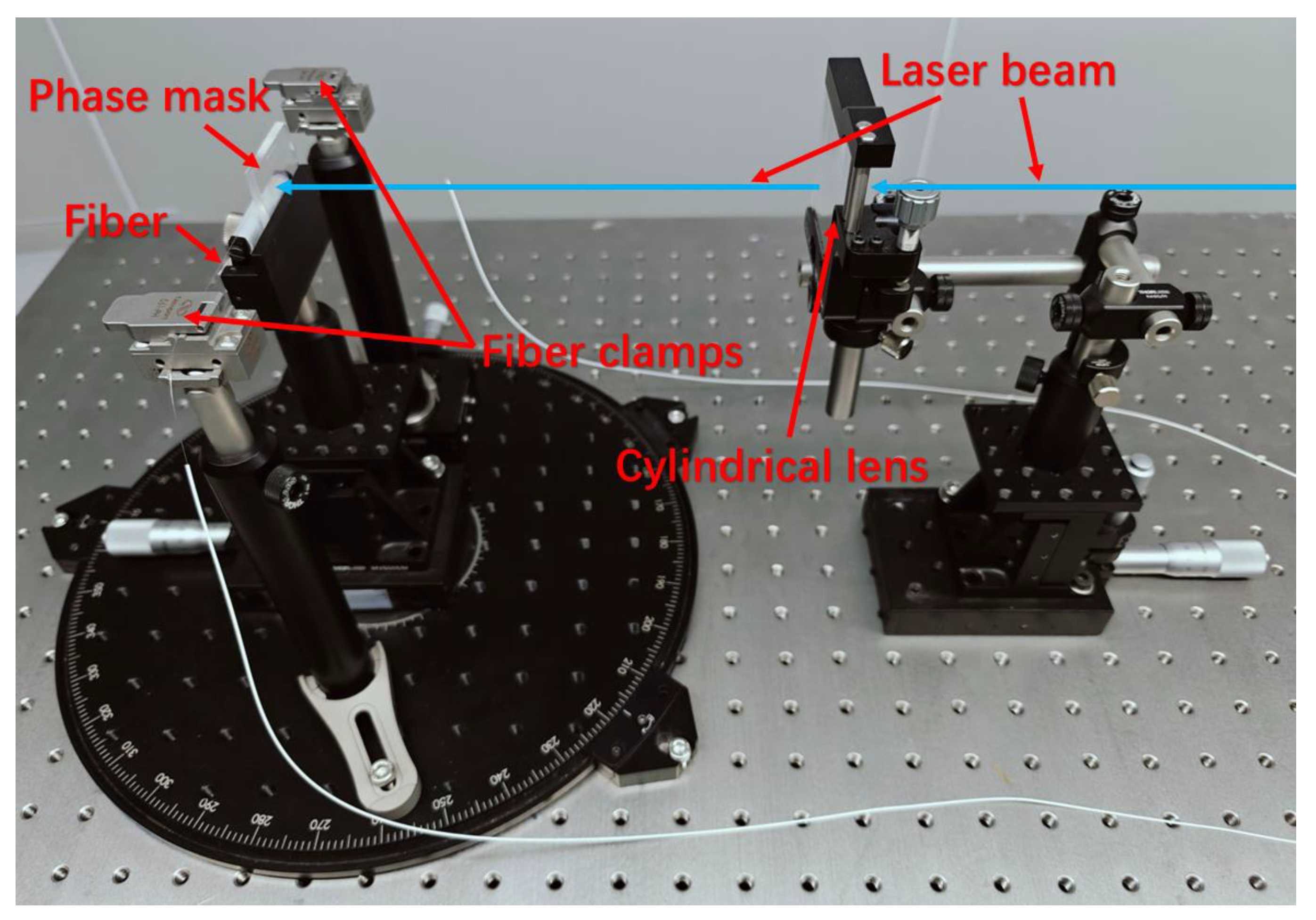


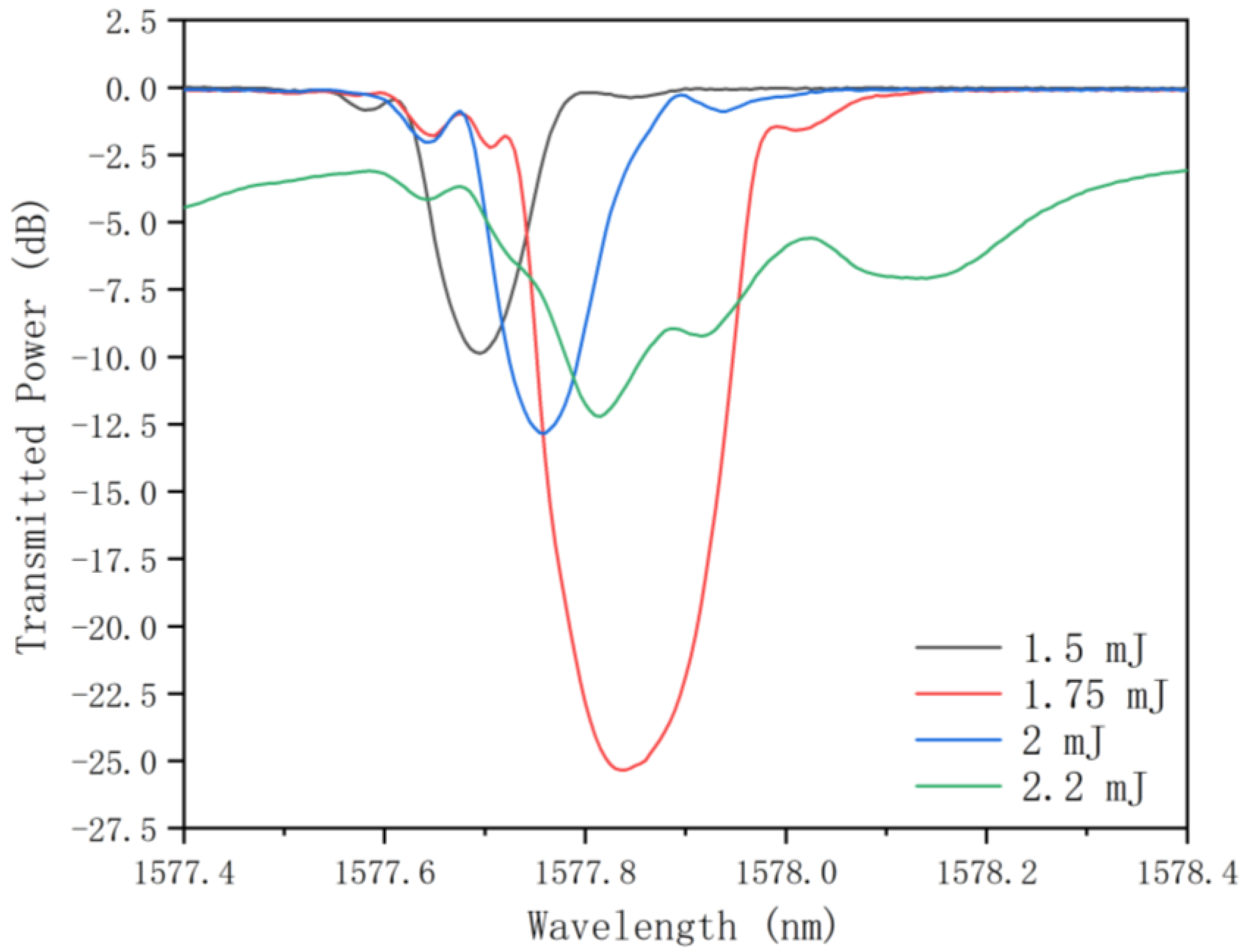
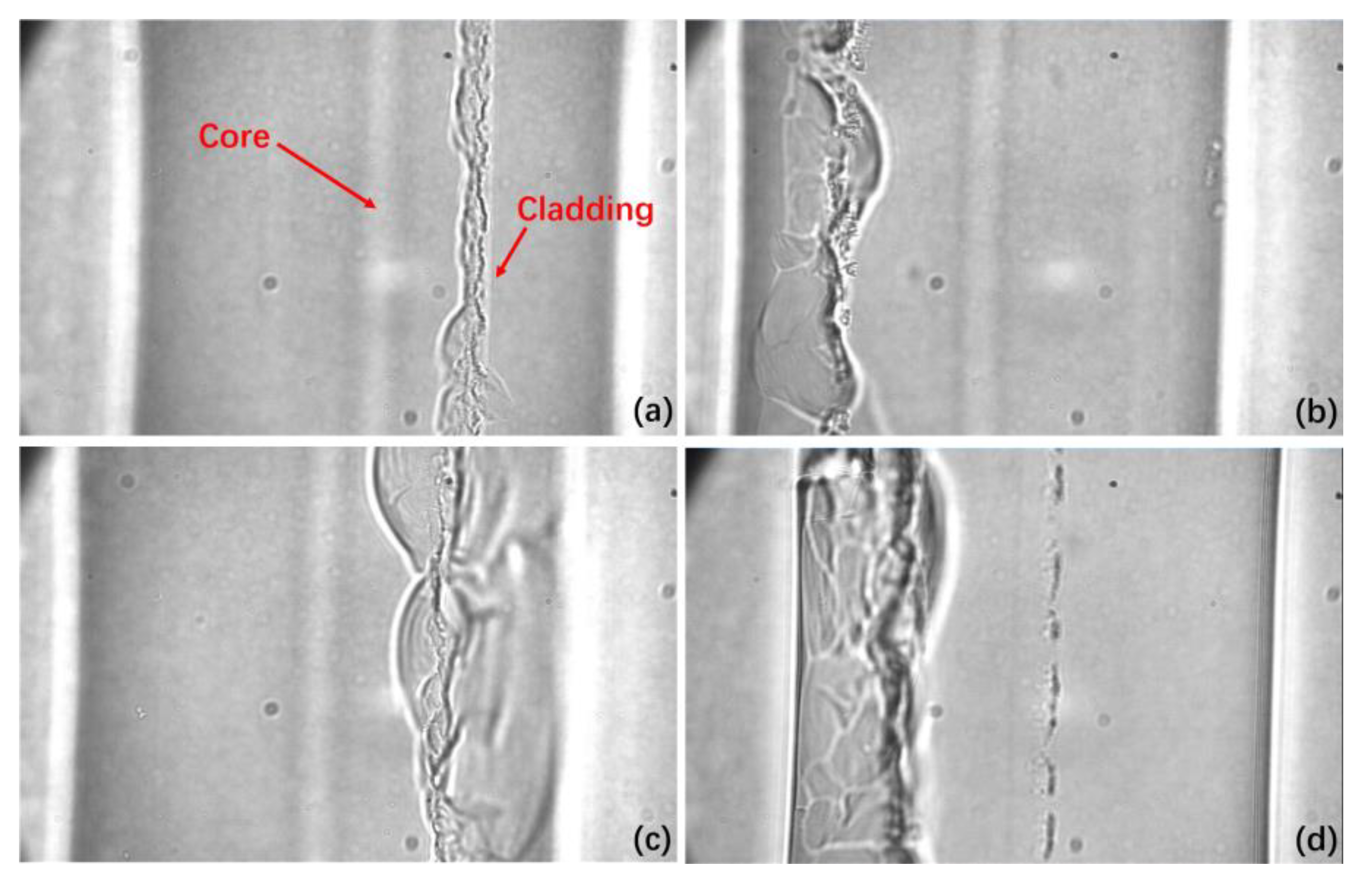
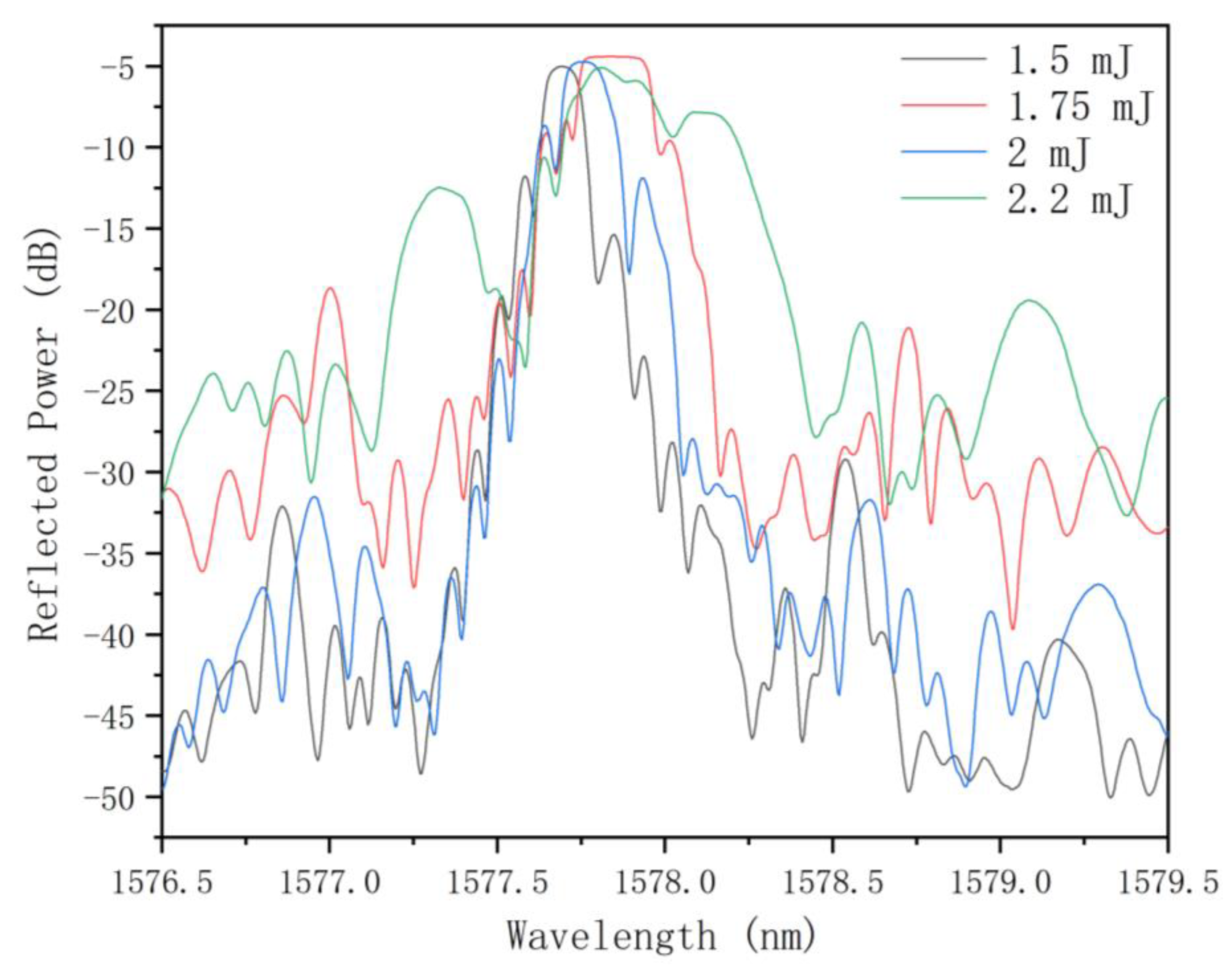

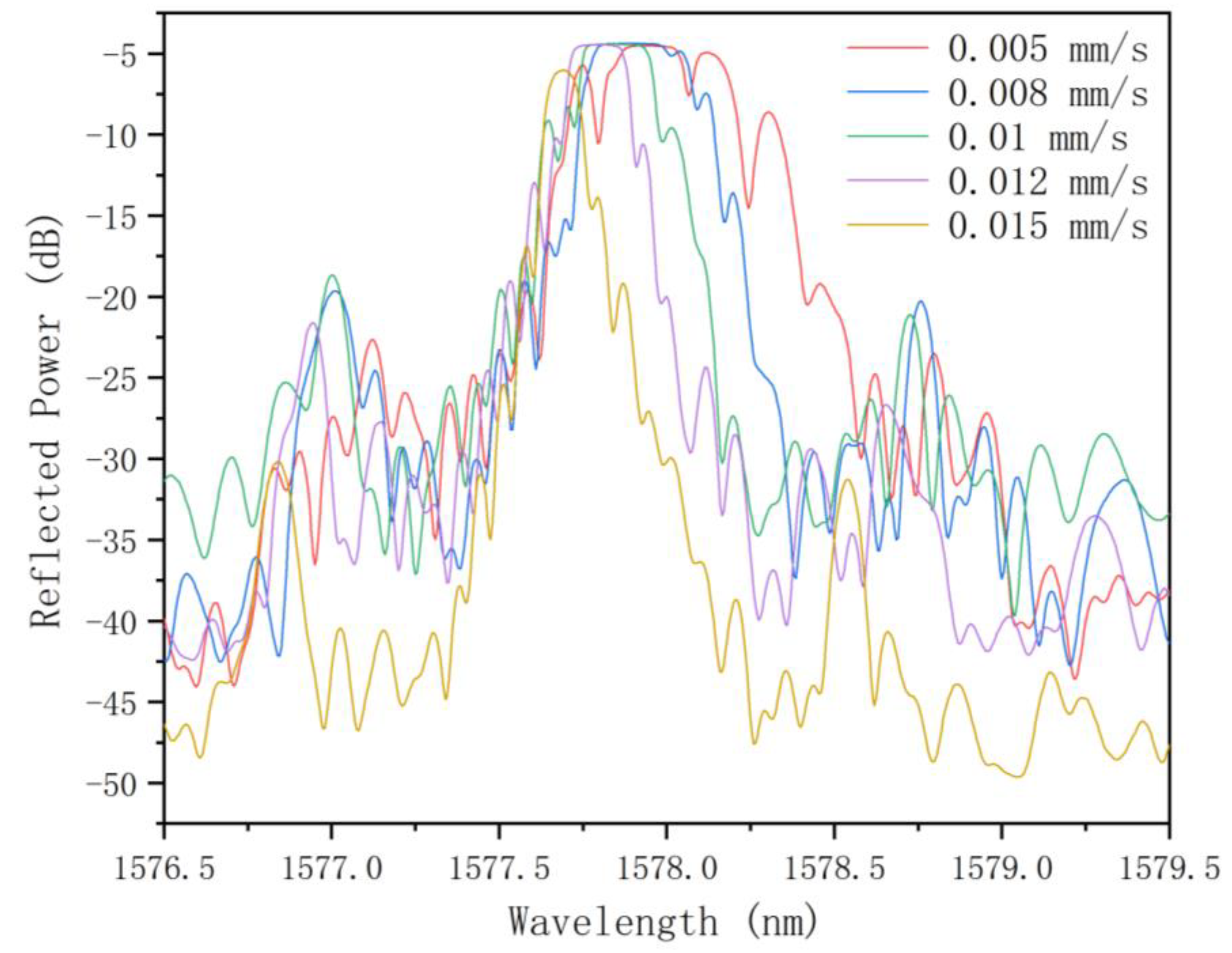
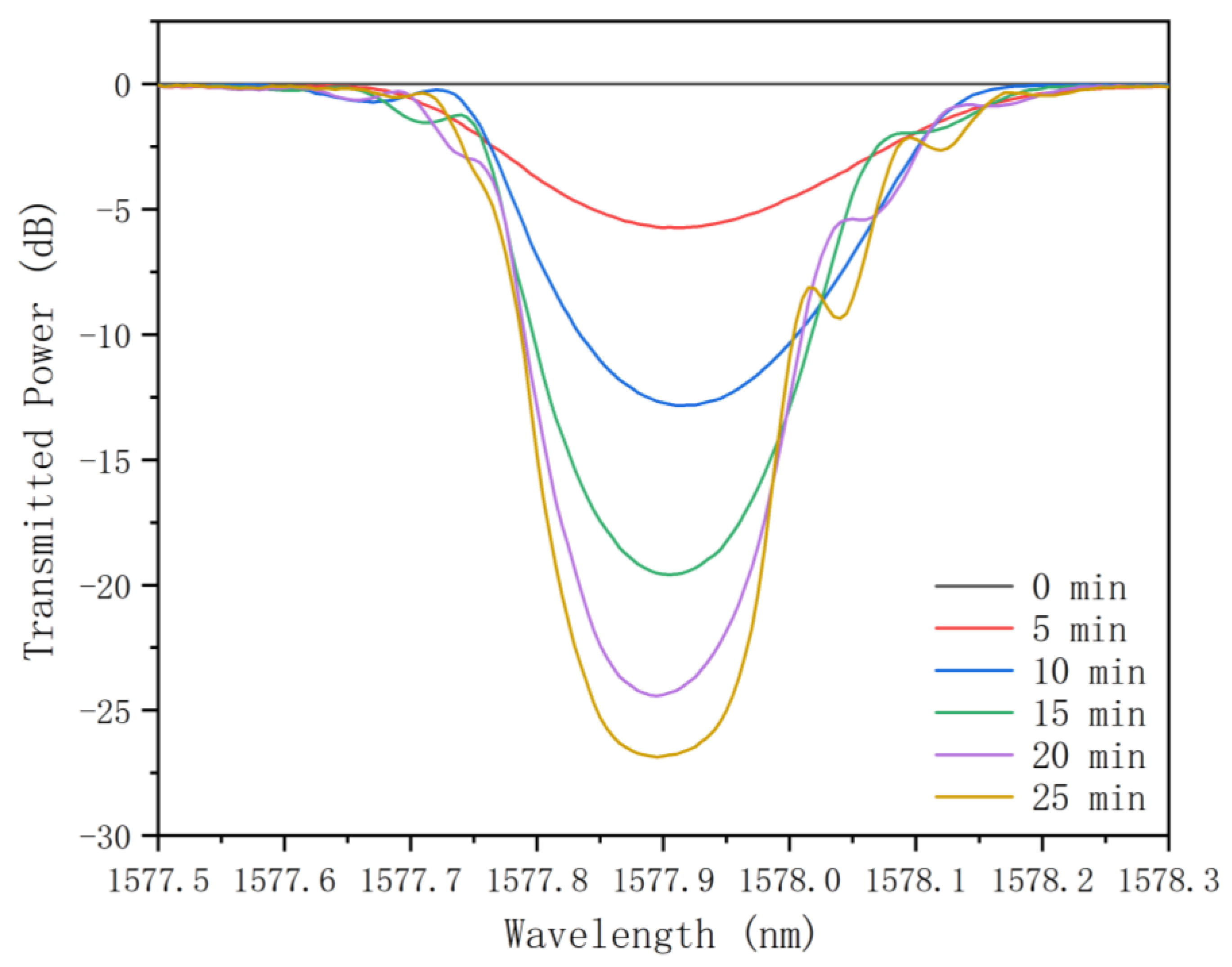
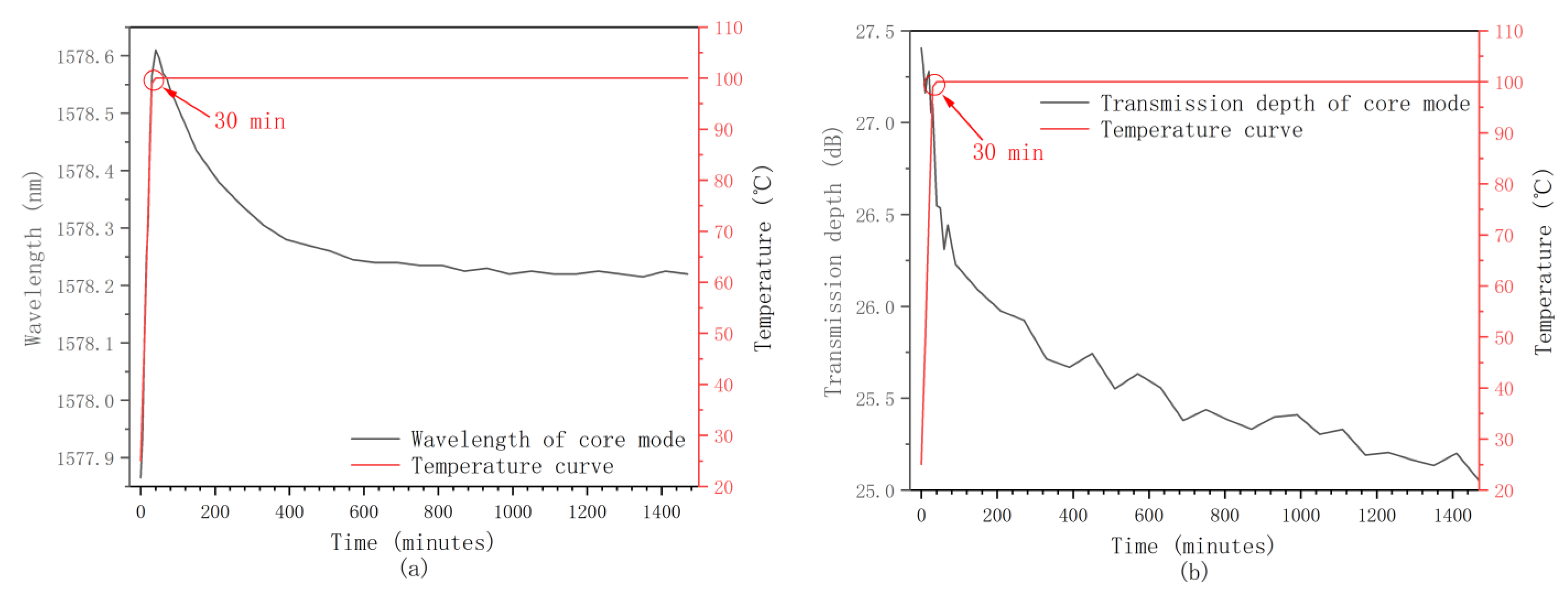


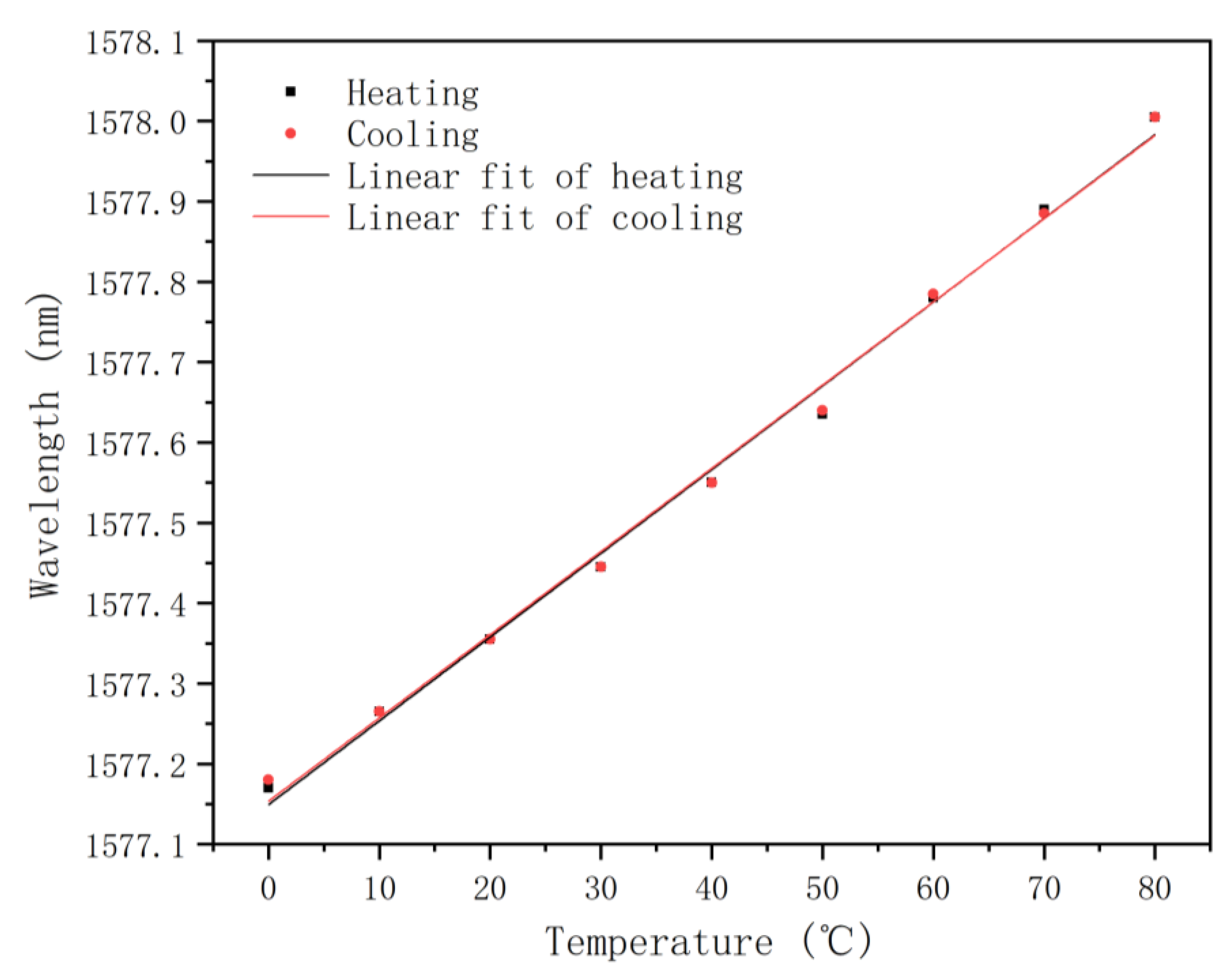
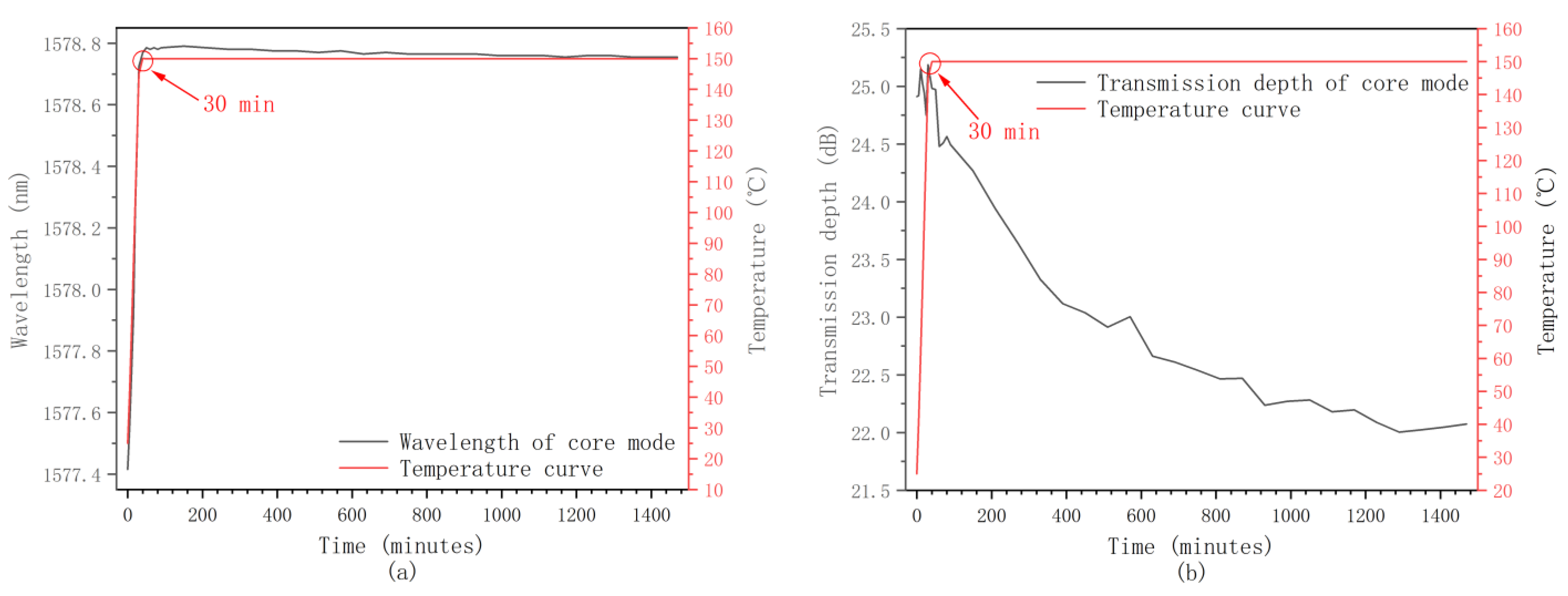



| Pulse Energy (mJ) | Scanning Speed (mm/s) | Wavelength of Core Mode (nm) | Transmission Depth of Core Mode (dB) | Reflectivity of the Grating (%) | FWHM (nm) | SMSR (dB) |
|---|---|---|---|---|---|---|
| 1.75 | 0.012 | 1577.790 | 21.1 | 99.23 | 0.19 | 5.76 |
| 2.00 | 0.012 | 1577.825 | 19.5 | 98.87 | 0.18 | 3.81 |
| 2.20 | 0.012 | 1577.865 | 23.9 | 99.60 | 0.26 | 3.06 |
| 1.50 | 0.010 | 1577.695 | 9.9 | 89.69 | 0.12 | 6.77 |
| 1.75 | 0.010 | 1577.835 | 25.3 | 99.71 | 0.23 | 3.85 |
| 2.00 | 0.010 | 1577.755 | 12.8 | 94.77 | 0.15 | 3.91 |
| 1.75 | 0.005 | 1577.935 | 19.5 | 98.87 | 0.25 | 1.18 |
| 1.75 | 0.008 | 1577.905 | 27.1 | 99.81 | 0.33 | 3.07 |
| 1.75 | 0.015 | 1577.690 | 8.3 | 85.07 | 0.11 | 7.81 |
Disclaimer/Publisher’s Note: The statements, opinions and data contained in all publications are solely those of the individual author(s) and contributor(s) and not of MDPI and/or the editor(s). MDPI and/or the editor(s) disclaim responsibility for any injury to people or property resulting from any ideas, methods, instructions or products referred to in the content. |
© 2024 by the authors. Licensee MDPI, Basel, Switzerland. This article is an open access article distributed under the terms and conditions of the Creative Commons Attribution (CC BY) license (https://creativecommons.org/licenses/by/4.0/).
Share and Cite
Zhu, X.; Xin, Z.; Zhu, H.; Wang, H.; Cheng, X.; Tam, H.-Y.; Qu, H.; Hu, X. Inscription and Thermal Stability of Fiber Bragg Gratings in Hydrogen-Loaded Optical Fibers Using a 266 nm Pulsed Laser. Photonics 2024, 11, 1092. https://doi.org/10.3390/photonics11111092
Zhu X, Xin Z, Zhu H, Wang H, Cheng X, Tam H-Y, Qu H, Hu X. Inscription and Thermal Stability of Fiber Bragg Gratings in Hydrogen-Loaded Optical Fibers Using a 266 nm Pulsed Laser. Photonics. 2024; 11(11):1092. https://doi.org/10.3390/photonics11111092
Chicago/Turabian StyleZhu, Xiangxi, Zixuan Xin, Haoming Zhu, Hongye Wang, Xin Cheng, Hwa-Yaw Tam, Hang Qu, and Xuehao Hu. 2024. "Inscription and Thermal Stability of Fiber Bragg Gratings in Hydrogen-Loaded Optical Fibers Using a 266 nm Pulsed Laser" Photonics 11, no. 11: 1092. https://doi.org/10.3390/photonics11111092
APA StyleZhu, X., Xin, Z., Zhu, H., Wang, H., Cheng, X., Tam, H.-Y., Qu, H., & Hu, X. (2024). Inscription and Thermal Stability of Fiber Bragg Gratings in Hydrogen-Loaded Optical Fibers Using a 266 nm Pulsed Laser. Photonics, 11(11), 1092. https://doi.org/10.3390/photonics11111092







